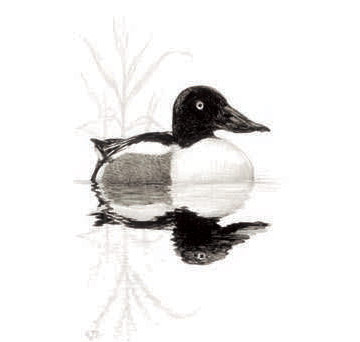
Shoveler © Ren Hathway
For many years in Britain, Shovelers seem to have been contracting their breeding range and increasingly concentrating on a limited number of sites, especially nature reserves and others with nature conservation designations (BTO Second Atlas). This also seems to be true in Cheshire and Wirral. As in our First Atlas, the species’ stronghold is the Mersey and lower Weaver valleys, and Shovelers were found in slightly more tetrads than twenty years ago (49 compared to 40), but with significantly fewer providing proof of breeding (3 compared to 11). Females were seen with ducklings in SJ57N in the lower Weaver valley, at Woolston (SJ68J) and Risley Moss (SJ69Q). Birds were recorded visiting a probable nest site or displaying in a further three tetrads, SJ27X on the Dee saltmarsh, Inner Marsh Farm (SJ37B) and Woolston (SJ68P), with pairs seen in 23 more tetrads.
In the 19 years between our two Atlas periods (1985-2003), the annual county bird reports have logged confirmed breeding in 16 of the 19 years, but never at more than three locations in a year. All of the sites have been in the north of the county: Woolston (15 years), Frodsham Marsh (4 years), Gatewarth SF (4 years), Fiddlers Ferry (2 years), Astmoor (2 years), St Helens Canal (2 years) and Risley Moss (1 year).
The species’ habitat requirements are defined by its remarkable bill, from which it gets both its common and scientific names (clypeata = shield-shaped). The prominent projections (lamellae) on its upper and lower mandibles strain material taken in through the tip of the bill, allowing it to feed on tiny particles including plankton. With this method of feeding, they mainly choose shallow eutrophic waters with nutritious material suspended in the water, and may well lose out in competition with fish.
Unusually for a dabbling duck, breeding Shovelers are territorial, the males defending a feeding territory for the pair. The female nests in vegetation, usually not far from the water’s edge, in late April, and incubates the eggs for just over three weeks while the drake stays nearby on the water. Any furtive-looking single male Shoveler in May should be watched carefully in case he has a duck on a nest in the vicinity: she comes off the nest to feed in bouts adding up to three or four hours a day, more than other ducks. With these aspects of behaviour, a briefly-observed male or pair could actually be nesting. Broods of up to 12 chicks have been seen, but 8 or 9 is more normal, and many of the males accompany their female with the brood.
Nationally, there were estimated to be over 1,000 breeding pairs in Britain in 1988-91 (BTO Second Atlas), but Shoveler has now (2007) been added to the list of species monitored by the UK Rare Breeding Birds Panel because of its perceived scarcity. The county population is unlikely to be more than 5 pairs breeding.
Sponsored by Syngenta CTL

